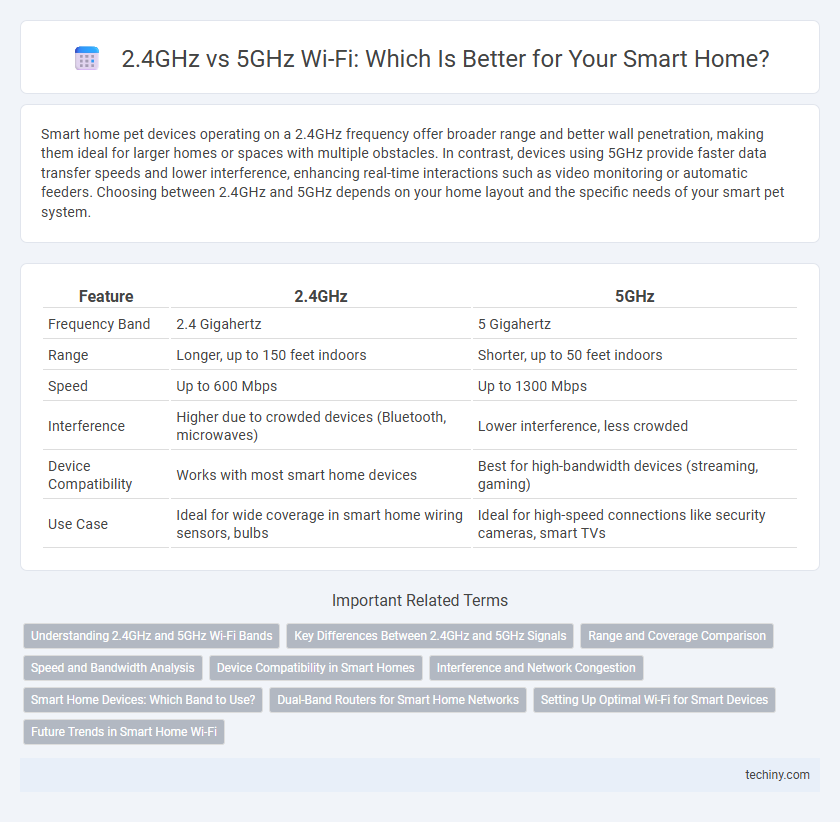Smart home pet devices operating on a 2.4GHz frequency offer broader range and better wall penetration, making them ideal for larger homes or spaces with multiple obstacles. In contrast, devices using 5GHz provide faster data transfer speeds and lower interference, enhancing real-time interactions such as video monitoring or automatic feeders. Choosing between 2.4GHz and 5GHz depends on your home layout and the specific needs of your smart pet system.
Table of Comparison
| Feature | 2.4GHz | 5GHz |
|---|---|---|
| Frequency Band | 2.4 Gigahertz | 5 Gigahertz |
| Range | Longer, up to 150 feet indoors | Shorter, up to 50 feet indoors |
| Speed | Up to 600 Mbps | Up to 1300 Mbps |
| Interference | Higher due to crowded devices (Bluetooth, microwaves) | Lower interference, less crowded |
| Device Compatibility | Works with most smart home devices | Best for high-bandwidth devices (streaming, gaming) |
| Use Case | Ideal for wide coverage in smart home wiring sensors, bulbs | Ideal for high-speed connections like security cameras, smart TVs |
Understanding 2.4GHz and 5GHz Wi-Fi Bands
The 2.4GHz Wi-Fi band offers broader coverage and better penetration through walls, making it ideal for smart home devices spread across larger areas. The 5GHz band delivers faster data speeds with less interference but shorter range, suitable for high-bandwidth applications near the router. Understanding the strengths of each band helps optimize smart home network performance by balancing coverage and speed.
Key Differences Between 2.4GHz and 5GHz Signals
The 2.4GHz signal offers a longer range and better wall penetration, making it ideal for larger smart home setups with multiple obstacles. In contrast, the 5GHz signal provides faster data speeds and less interference, suitable for high-bandwidth devices like smart TVs and security cameras. Choosing between 2.4GHz and 5GHz depends on balancing coverage needs with performance demands in smart home networks.
Range and Coverage Comparison
The 2.4GHz frequency offers broader range and better penetration through walls, making it ideal for smart home devices spread across multiple rooms or floors. In contrast, the 5GHz frequency provides faster data rates with less interference but has a shorter range and limited ability to pass through solid obstacles. Choosing between 2.4GHz and 5GHz depends on the specific coverage needs and layout of the smart home environment.
Speed and Bandwidth Analysis
The 5GHz frequency band offers faster speeds and higher bandwidth compared to the 2.4GHz band, making it ideal for bandwidth-intensive smart home devices like video streaming cameras and smart TVs. While 2.4GHz provides broader coverage and better penetration through walls, its limited bandwidth can cause slower data transmission and increased interference from other household electronics. Optimizing smart home networks by prioritizing 5GHz for high-speed data devices ensures smoother operation and reduces latency in connected smart appliances.
Device Compatibility in Smart Homes
Smart home devices often rely on 2.4GHz Wi-Fi bands due to their broader compatibility with a wide range of sensors, cameras, and smart plugs. While 5GHz offers faster speeds and less interference, many smart home gadgets do not support this frequency, limiting device options on 5GHz networks. Ensuring optimal device compatibility and stable connectivity requires prioritizing 2.4GHz for seamless integration and efficient smart home performance.
Interference and Network Congestion
The 2.4GHz band is more prone to interference from common household devices like microwaves, Bluetooth gadgets, and cordless phones, often leading to network congestion in densely populated areas. In contrast, the 5GHz band offers more channels and less interference, providing better performance for smart home devices requiring high bandwidth and low latency. Choosing 5GHz can reduce network congestion and improve the stability of smart home automation systems.
Smart Home Devices: Which Band to Use?
Smart home devices often benefit from the 2.4GHz band due to its longer range and better wall penetration, making it ideal for devices like smart bulbs, security cameras, and thermostats spread across a home. The 5GHz band provides higher speeds and less interference, suited for bandwidth-intensive devices such as smart TVs, streaming devices, and hubs located closer to the router. Choosing the right band depends on device requirements, home layout, and the need for stability versus speed.
Dual-Band Routers for Smart Home Networks
Dual-band routers operating on both 2.4GHz and 5GHz frequencies enhance smart home networks by balancing range and speed; 2.4GHz offers broader coverage and better penetration through walls, while 5GHz delivers faster data rates with less interference. Devices such as smart thermostats, security cameras, and voice assistants benefit from 2.4GHz for stable connectivity over distances, whereas high-bandwidth applications like streaming smart TVs prefer the 5GHz band for optimal performance. Integrating dual-band technology ensures seamless communication among diverse smart home gadgets, reducing latency and improving overall network reliability.
Setting Up Optimal Wi-Fi for Smart Devices
Choosing between 2.4GHz and 5GHz bands significantly impacts smart home connectivity; 2.4GHz offers broader range and better wall penetration, ideal for devices spread across larger areas. The 5GHz band provides higher speeds with less interference, benefitting bandwidth-heavy devices near the router for smooth streaming and faster data transfer. Optimizing Wi-Fi for smart devices involves assigning 2.4GHz to sensors and thermostats requiring consistent signals and reserving 5GHz for cameras and hubs demanding higher throughput and low latency.
Future Trends in Smart Home Wi-Fi
Future trends in smart home Wi-Fi emphasize the integration of 5GHz bands due to their superior speed and reduced interference, essential for supporting multiple connected devices and high-bandwidth applications like 4K streaming and real-time security monitoring. The 2.4GHz band remains relevant for its extended range and better wall penetration, making it ideal for IoT devices such as smart thermostats, lighting, and sensors that require stable but lower bandwidth connections. Emerging Wi-Fi 6 and Wi-Fi 6E technologies further enhance dual-band performance, promising lower latency, increased capacity, and improved energy efficiency for increasingly complex and dense smart home networks.
2.4GHz vs 5GHz Infographic

 techiny.com
techiny.com